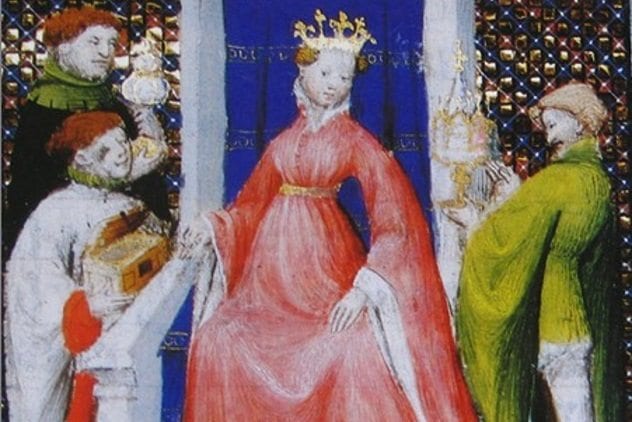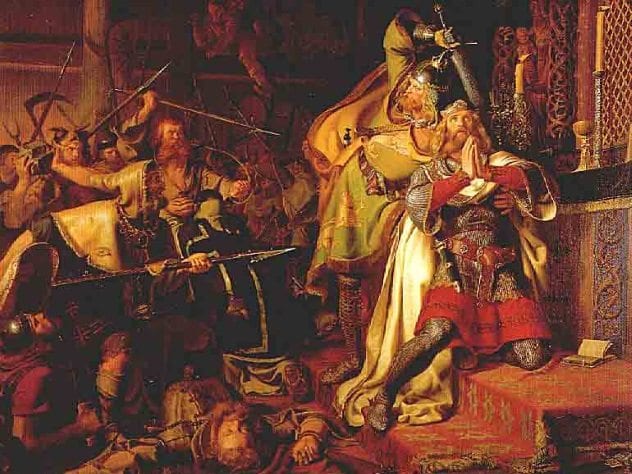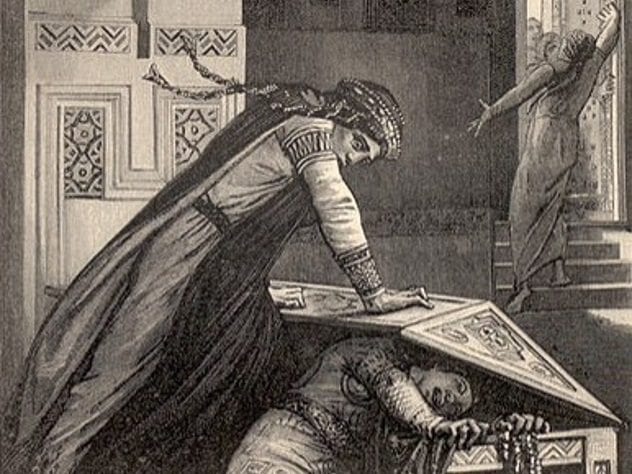 Mysteries
Mysteries  Mysteries
Mysteries  Miscellaneous
Miscellaneous 10 Everyday Terms with Surprising Historical Origins
 Humans
Humans 10 Genius Inventors with Highly Suspicious Deaths
 Weird Stuff
Weird Stuff 10 Weirdest Concept Car Designs Ever
 Movies and TV
Movies and TV The 10 Most Memorable Commercials of All Time
 Crime
Crime 10 Shocking Facts About the Electric Chair
 History
History 10 Cool Gold Rushes They Don’t Teach in History Class
 Pop Culture
Pop Culture Science Fiction’s Ten Coolest Spaceships
 Weird Stuff
Weird Stuff 10 Strange Traditions and Rituals on Transatlantic Ships
 Miscellaneous
Miscellaneous 10 Things You May Not Know About the London Underground
 Mysteries
Mysteries 10 “Ancient Alien” Artifacts That Have Mundane Explanations
 Miscellaneous
Miscellaneous 10 Everyday Terms with Surprising Historical Origins
 Humans
Humans 10 Genius Inventors with Highly Suspicious Deaths
Who's Behind Listverse?

Jamie Frater
Head Editor
Jamie founded Listverse due to an insatiable desire to share fascinating, obscure, and bizarre facts. He has been a guest speaker on numerous national radio and television stations and is a five time published author.
More About Us Weird Stuff
Weird Stuff 10 Weirdest Concept Car Designs Ever
 Movies and TV
Movies and TV The 10 Most Memorable Commercials of All Time
 Crime
Crime 10 Shocking Facts About the Electric Chair
 History
History 10 Cool Gold Rushes They Don’t Teach in History Class
 Pop Culture
Pop Culture Science Fiction’s Ten Coolest Spaceships
 Weird Stuff
Weird Stuff 10 Strange Traditions and Rituals on Transatlantic Ships
 Miscellaneous
Miscellaneous 10 Things You May Not Know About the London Underground
10 Royal Murders That Shocked Medieval Europe
These days, Europe’s kings and queens are cozy anachronisms, trotted out on ceremonial occasions and largely ignored for the rest of the year. But for 1,000 years, the royal families of Europe murdered and feuded ruthlessly in search of absolute power. Assassinations were common, and many a medieval tyrant ended his days failing to fend off a sudden knife thrust.
10Eric V Of Denmark

In 1286, a mysterious group of apparent Franciscan monks rode into the village of Finderup. They were heading for the barn where King Eric V of Denmark and his entourage were sleeping after a hunting expedition in the local woods. As the hunters snoozed, the murderous monks silently entered the barn and stabbed the king to death.
In the ensuing confusion, the assassins ditched their monk costumes and made a clean getaway. King Eric was an unpopular tyrant who had plenty of enemies, and it was unclear who had ordered the murder. In an atmosphere of paranoia, the Danes quickly convicted nobleman Stig Andersen Hvide, who hated Eric for sleeping with his wife.
No evidence linked Hvide to the killing, and he refused to submit to such a ruling. Instead, he fled to the island of Hjelm and became a pirate, raiding and looting the coast of Denmark until his death seven years later.
9Alboin

Alboin was king of the Lombards and one of the most powerful and remarkable figures of sixth-century Europe. It was he who led the Lombards south into Italy, conquering the north of the country.
No one could stand against Alboin on the battlefield. But his savagery eventually backfired on him. Early in his reign, he killed King Cunimund of the Gepids and turned his skull into a drinking cup. Then he forcibly married Cunimund’s daughter, Rosemund. During one drunken feast in June 572, he invited Rosemund to “drink happily with her father” and made her sip wine from the skull cup.
This was a step too far, and Rosemund immediately began plotting his murder. She disguised herself as a servant and seduced Alboin’s bodyguard, Peredeo. She then revealed her true identity and threatened to tell Alboin about the affair unless Peredeo killed him. Knowing that Alboin would surely have him executed, Peredeo agreed and hacked the king to death in his bedchamber, completing Rosemund’s revenge.
8Andrew Of Hungary

When King Robert of Naples died in 1343, the throne passed to his teenage granddaughter, Joanna. She was married to her cousin, Prince Andrew of Hungary, and the expectation was that he would rule Naples in her name. But Joanna was a ruthlessly determined young woman who insisted that she was queen and Andrew merely her husband.
A bitter political struggle soon broke out between the couple. The people of Naples supported Joanna, despising Andrew as a foreigner who surrounded himself with other Hungarians. Before long, the prince was writing to his mother that he feared for his life.
In 1344, Andrew was undressing for bed when armed men burst into the room, beat him severely, and then hung him from a balcony. When the noose failed to strangle him immediately, some of the assassins swung from his legs to speed things up. The plan was apparently to hide his body, but Andrew’s childhood nurse heard the murder and raised the alarm. Joanna declared her innocence, claiming that she had been asleep in the next room the whole time.
7Joanna Of Naples

The assassination of her husband backfired on Joanna. Andrew’s Hungarian relatives immediately invaded Naples, bent on revenge. However, Joanna was a formidable adversary, and she eventually regained her kingdom.
As it turned out, the Hungarians were merely biding their time. In 1380, they enthusiastically backed Joanna’s distant relative, Charles of Durazzo, who had been granted the throne by one of the Church’s two feuding popes. Charles successfully invaded Naples and captured Joanna.
But Joanna had one last trick up her sleeve. Before she was captured, she announced that she was adopting Prince Louis of France and making him her successor. The delighted Louis raised a huge French army to free his new mother, but she was assassinated in 1382 by Charles before the French could get to her.
Most accounts say that her Hungarian killers strangled her, just as Andrew had been strangled. However, Prince Louis’s wife, Marie, wrote that she was actually smothered with a feather mattress, to avoid leaving marks on her body.
6Charles Of Durazzo

After murdering Joanna, Charles of Durazzo became king of Naples. (Louis of France helped out by dropping dead of disease.) Since grabbing a kingdom from his female relative had worked out so well the first time, he decided to give it another go when Louis of Hungary died, and his daughter, Mary, took the throne.
Charles invaded Hungary and successfully displaced Mary. But he had severely underestimated Mary’s mother, the fearsome Elizabeth of Bosnia. She had already firmly secured Poland for her older daughter, Jadwiga, and now she was determined to do the same for Mary in Hungary.
Pretending to welcome Charles, Elizabeth won his trust and was actually with him in Buda Castle when her assassin stuck a hatchet in his neck in 1386. The act effectively secured the Hungarian throne for Mary, although Elizabeth wasn’t around to see it: Charles’s wife had her strangled in revenge.
5Tsarevich Dmitry

Ivan the Terrible was unlucky with his sons. The first drowned as a baby when the royal boat capsized. Ivan personally murdered the second in a fit of rage. As a result, the throne went to his third son, Feodor, who may have been mentally disabled and allowed the regent Boris Godunov to rule on his behalf.
That left Ivan’s youngest son, Dmitry, as a potential threat to Godunov’s power. To nobody’s surprise, the eight-year-old boy was soon found with a knife in his neck in 1591. Astonishingly, Godunov attempted to claim that that Dmitry had accidentally brutally cut his own throat after suffering an epileptic seizure while holding a knife.
This medically unlikely story persuaded approximately nobody, especially since an important witness disappeared while en route to testifying. Others accused the Bitigavosky family, who were all killed in an ensuing riot. Three separate imposters later seized control of areas of Russia by claiming to be the real Dmitry, spirited away before the murder.
4Aedh Ua Conchobair

Not all royal murders had political motives. Take the case of Aedh Ua Conchobair, who ruled the west of Ireland as the king of Connacht in the early 13th century. According to the Annals of Connacht, Aedh was killed while visiting Geoffrey de Mareys, the English justiciar in Ireland, in 1228.
As recorded in the Annals, Aedh was a famously handsome man with an eye for the ladies. Geoffrey ordered a serving woman to bathe his guest, which sent her husband, a carpenter, into a jealous rage. He seized a wood axe, burst into the room, and hacked Aedh to death in the bath.
Geoffrey had the carpenter hanged the very next day, which seems slightly harsh, since the Annals record that Geoffrey’s own son had deliberately fueled the carpenter’s jealousy, hoping to get Aedh out of the picture.
3Charles The Good

Charles the Good became count of Flanders under dramatic circumstances. His cousin, the childless Count Baldwin, was mortally wounded in battle and willed his title to Charles with his dying breath. The new count soon endeared himself to his subjects through numerous acts of charity.
Unfortunately, Charles also made enemies of the wealthy Erembald family, who had risen to power under even more dramatic circumstances. The original Erembald was a serf who served the castellan of Bruges—while secretly having an affair with his wife. One day, the castellan was urinating over the side of a boat when Erembald shoved him into the water, where he drowned. Erembald then married his widow and became the new castellan.
When Erembald’s descendants grew too powerful, Charles decided to reduce them back to the status of serfs in 1127. This panicked the Erembalds, who sent their knights into the church where Charles was praying. The knights “knocked his brains out onto the floor.”
2Canute IV

Charles the Good should really have been more careful, since he was the son of King Canute IV of Denmark, who was also killed in a church by his enemies. But while Charles fell out with a family of wealthy magnates, Canute’s killers were humble peasants.
Canute was a pious man who suppressed paganism and greatly enhanced the power of the Danish church, to the point that he was later made a saint. Unfortunately, he also demanded that the peasants pay a tithe to the church, which infuriated the people. To make matters worse, a planned invasion of England fell apart due to infighting.
By 1086, a general rebellion had broken out against his rule. Canute barricaded himself in a church at Odense, surrounded by his enemies. The praying king was wounded by a spear hurled through the window. The rebels then broke down the door and finished him off in a hail of arrows.
1Galswintha, Sigebert, And Chilperic

The most remarkable and ruthless woman of the sixth century started life as a slave in the court of the Frankish king Chilperic. Her name was Fredegund, and she soon caught the eye of the king. But Fredegund was unwilling to remain a mistress, and Queen Galswintha was soon strangled, with Fredegund replacing her as Chilperic’s wife.
Unfortunately, Galswintha’s sister was Brunhilde, wife of Chilperic’s brother, Sigebert, who attacked in search of revenge. Sigebert was victorious in battle but was assassinated in his hour of triumph on Fredegund’s orders. Fredegund also made numerous attempts to assassinate Brunhilde, although her doughty rival survived them all.
Over the next three decades, Fredegund ordered so many murders that it’s impossible list them all here. Her notable victims include most of Chilperic’s sons from earlier marriages, numerous bishops and nobles, and probably Chilperic himself, who was mysteriously murdered in 584. She also ordered a failed attempt on the life of King Guntram of Burgundy and forced Brunhilde’s second husband into suicide.
But Fredegund was more than a crazed killer. She cemented her popularity by persuading her husband to lower taxes. And she successfully defended her position after Chilperic’s murder, ensuring that her son would take the throne.








